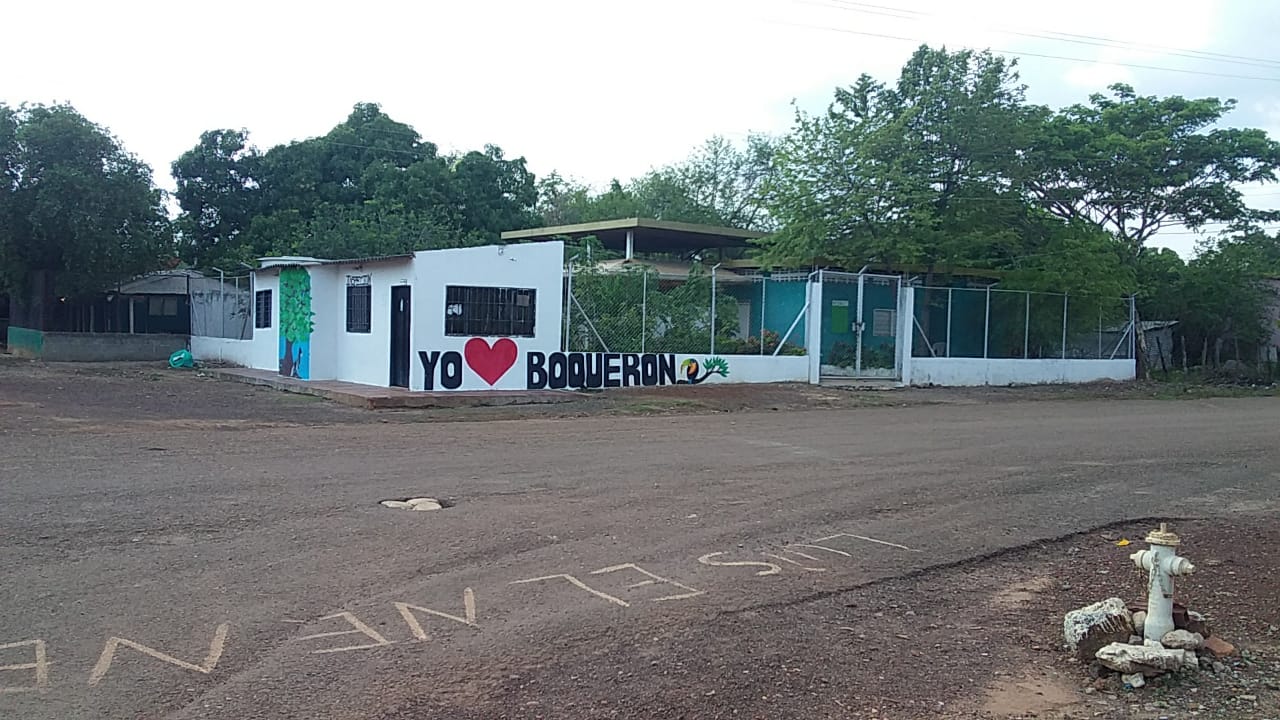
What will happen to Cesar, Colombia when the mines leave?
Coal mines have caused environmental devastation to the Cesar department of Colombia. But now that the Swiss mining company Glencore announced that they will withdraw from the department, where they operate two mines, residents fear that the company will skip out on its legal obligations to the affected communities.
Boquerón is a small town on the plains of the northeastern Colombian department of Cesar, not far from the Venezuelan border. It can get so hot in Boquerón that you sweat standing still, and the streets are usually deserted around the middle of the day. Flower Arias told me about his childhood there, about how he used to be free to roam the plains, go for a swim, or go hunting.
“We were humble, not poor,” he said.
That was when the cash crop was cotton and they had a “campesino culture,” of farming staples such as yuca and plantain, before multinational corporations dug five large-scale open-pit coal mines in the area surrounding Boquerón, changing the region forever.
“Sickness, environmental contamination, robberies, sexual violence, these are the memories that the mines are going to leave,” Arias said.
On February 4, one of the three multinational corporations, Prodeco (a subsidiary of the Swiss mining giant Glencore), announced they were returning their mining contracts to the Colombian government and halting operations in Colombia. The company said the low price for coal has made their operations “economically unviable.” Many living in Cesar’s mining corridor are uneasy, as it isn’t clear who will assume the responsibility of Prodeco’s environmental and social liabilities or what will replace this source of employment and royalties for local governments.
“The country runs the risk that this company will leave without having given a plan to close the mine, which is mandatory, and without resolving the social and environmental problems that it generated during its time here, as communities and organizations have denounced for years,” read a communiqué signed by dozens of Colombian civil society organizations and Colombian Lawmakers.
Arias agrees.
“The company has to respond for everything it has done wrong,” he said. “From this point of view, they haven’t fulfilled anything. They need to take care of their environmental liabilities.”
Cesar’s mining corridor consists of the municipalities of Agustín Codazzi, Becerril, El Paso, and La Jagua de Ibirico. The region produced just over 52 million metric tons of coal in 2019, accounting for 61% of Colombia’s production. Colombia exported 88% of the coal it produced that year, with Turkey buying the most.
Prodeco has five mining titles across two mines, La Jagua and Calenturitas, which have been operating since 2004. Those two mines produced about 30% of Cesar’s coal in 2019, providing $206 million in royalties and taxes for the Colombian state.
Colombia’s National Mining Agency is responsible for awarding mining concessions. This can, for example, grant a company such as Prodeco the right to exploit a certain mineral for a certain amount of time; the Autoridad Nacional de Licencias Ambientales (National Environmental Licensing Authority, ANLA) must give its approval, taking into account environmental and social standards.
While the option for companies to renounce their concessions has always existed, this is the first time a multinational corporation has done so in Colombia. To sort through all the financial, environmental, and social liabilities Prodeco may or may not have, the Colombian State has appointed an “inter-institutional commission.”
“I don’t know how the state is going to accept the return of those mining titles because they have a lot of responsibility,” Arias said.
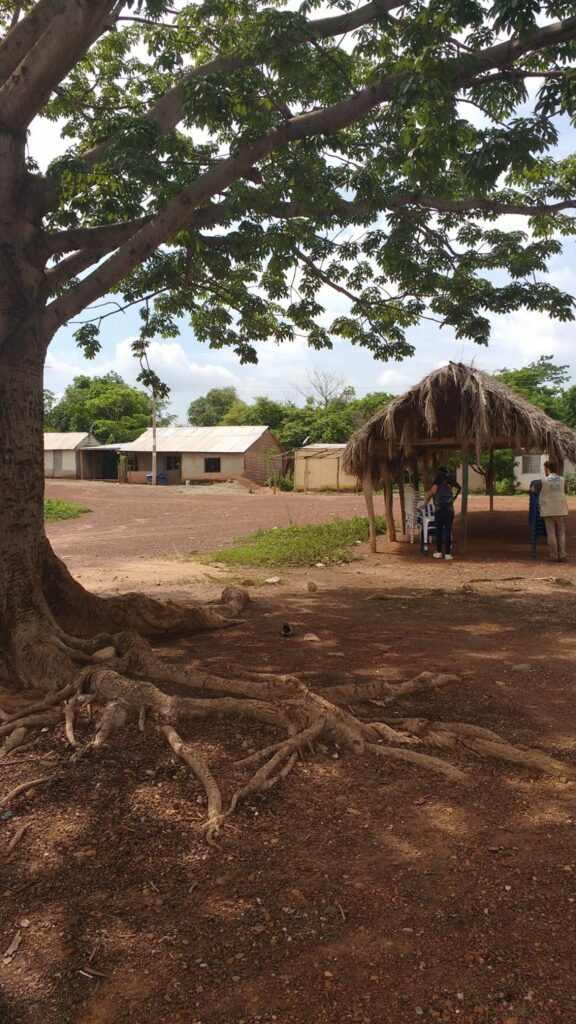
Photo: Thomas Power.
El Hatillo and Boquerón; waiting more than 10 years for involuntary resettlement
One notable liability Prodeco has is its responsibility for the involuntary resettlement of three Colombian villages: Boquerón, where Arias is from, as well as El Hatillo and Plan Bonito.
In 2010, the Colombian Ministry of Environment ordered the three multinational companies, Drummond, Prodeco, and Colombian Natural Resources (CNR), to resettle these communities because of dangerous air contamination caused by mining. The order said the resettlement had to be finished by 2012.
However, neither El Hatillo or Boquerón were resettled by the deadline. After drawn-out negotiations that lasted six years, the companies agreed to the Resettlement Action Plan for El Hatillo in 2018.
“For those living in the area, mining and agro industry have been responsible not only for changes in the use of the land, but also for air pollution and water pollution that have come with them,” said the organization Pensamiento y Acción Social (Social Thought and Action, PAS) in a written statement. “During the six years of negotiation, the companies used diverse strategies to wear out the community and its leaders, generate uncertainty, and break the communitarian social fabric.”
Yolima Parra, a community leader from El Hatillo, said the announcement that Prodeco is leaving has generated uncertainty and had a big impact on the people living there.
“We are suffering a humanitarian crisis due to unemployment and food scarcity,” Parra said. “No family has a stable source of employment or a way to get resources to feed themselves.”
In the municipality of El Paso, where El Hatillo is located, 21% of those living in rural zones had unmet basic needs in 2018, according to the Colombia’s National Administrative Department of Statistics (DANE). This number jumps to 35% in La Jagua de Ibirico, where Boquerón is located, and 34% and 67%, respectively, in Agustín Codazzi and Becerril, the other two municipalities of the mining corridor.
“[Prodeco] has to assume the obligations and commitments to take care of the environmental impacts that affect us and surrounding communities, they have to take responsibility for the environment and social responsibility for the communities,” Parra added, demanding above all that the company fulfill its responsibilities in the Resettlement Action Plan signed between the companies and the community in 2018.
Further complicating El Hatillo’s resettlement is that another of the three companies, CNR, declared bankruptcy in late 2020 and says they won’t be able to meet their resettlement obligations.
Parra says the only company that has been transparent as to what’s going on with the resettlement has been Drummond.
“Prodeco, we don’t have a lot of communication with them, only once because we demanded it,” Parra said.
He added that CNR has been similarly evasive.
According to a statement from Prodeco, however, they are committed to ensuring a sustainable and just transition for Colombia and surrounding communities.
“The decision to relinquish the mining contracts has not been taken lightly and is a disappointing outcome,” the company said in its February 4 statement.
The company also said they had invested $3 billion in the communities and had paid another $3 billion in royalties over the course of their operations. They claim they “will support our employees, contractors and neighboring communities in relation to the impact derived from the relinquishment of mining titles and the subsequent stages of the process.”
Prodeco did not return requests for an interview.
As for Boquerón, on February 2, 2021 the Environmental Ministry reclassified the area as not having high enough levels of air contamination to justify a resettlement. Local officials have reportedly committed to improve living conditions in Boquerón.
Arias, who grew up in Boquerón but now lives in the Department’s capital Valledupar, asserts that the mining companies still have an obligation to resettle the community, because while the Environmental Ministry has issued a resolution removing Boquerón from the area of contamination, the ANLA has not yet reversed the original order. The resolution to resettle the community is still in force. Arias is the legal representative of Boquerón’s Community Council, a special Colombian legal framework that affords Afro-Colombian communities a degree of territorial autonomy.
“Colombia’s constitution says you have a right to a safe environment, and to guaranteed healthcare, drinking water, education, but here some local authorities don’t do anything,” Arias said.
In March, nine Colombian lawmakers created a commission in the Colombian Congress “to monitor and verify large-scale coal mining in the Colombian Caribbean,” to oversee environmental, healthcare, labor, economic, judicial, and social and cultural issues in Cesar and La Guajira, another major coal-producing department.
Regional Impact
“It isn’t only [communities being resettled] that have been impacted, the whole mining corridor of Cesar has been affected, but people only focus on the resettlements,” said Ana Rivera, a member of Boquerón’s community council who lives in the urban center of La Jagua de Ibirico. “That’s to say Becerril, La Jagua, in the rural parts, they all have felt an impact.”
Rivera spoke specifically to the precarious access to water.
“We have an aqueduct, but water only comes out of the taps every three, four or five days,” she said. “The water is OK for cleaning, washing dishes, even for cooking if you treat it a bit. But for drinking, you have to buy it.”
One of the biggest impacts on the water system in the region was the diversion of the Calenturitas River, approved by Colombia’s environmental authority in 2009. This river was vital for the economy of the region, including El Hatillo, providing fish and other necessary resources.
“The biggest damage was the diversion of the river, because it had provided economic stability for the community,” Parra said.
In 2018, the National Comptroller released a report about the mining licenses in Cesar, finding a series of administrative and criminal violations of regional and national environmental authorities, including that rivers were diverted without the sufficient studies having been done.
“It should be noted that the pressure on natural resources from mining operations in the [central area of Cesar] has increased over the years, affecting or influencing the quality and quantity of water resources, loss of biodiversity, changes in land use, air quality (source area of pollution in the [Central Area of Cesar]), changes in geoforms, loss of ecosystem services and changes in social dynamics, including resettlement processes,” the report reads.
Aside from environmental and social damages, Prodeco has been implicated in funding paramilitary groups. Allegations of Prodeco funding these groups go back decades, and in February a documentary released by Deutsche Welle interviewed a demobilized paramilitary soldier who alleged complicity with mining companies operating in Cesar.
Both Prodeco and U.S. coal company Drummond, also accused of funding paramilitaries, released statements denying any involvement with paramilitary groups.
Drummond points to the lack of judicial sanctions as exculpatory, pointing out, “Drummond has prevailed in every case filed against it in the US based on allegations of collaboration with paramilitaries.”
However, in December 2020 the Colombian Public Prosecutor’s office accused the current and former presidents of Drummond in Colombia of having financed paramilitaries. That case is still in court.
Meanwhile, people who live in the mining corridor continue to suffer violence. In 2016, the negotiations between the mining companies and the community were getting progressively more tense, as they were approaching structural aspects of the resettlement such as access to land and housing. According to PAS, “at night they began to see armed men dressed in black… patrolling the streets close to the houses [of the leaders of the community].”
On January 7, 2017, the nephew of the president of the Communal Action Board (a figure that allows rural communities to organize themselves) was assassinated. The local human rights authority had warned that community leaders were at risk.
Leaders like Flower Arias and Yolima Parra are continuing to advocate for their communities and navigate a difficult set of relationships just to survive. What Arias and Parra are demanding is that Prodeco assume its social and environmental responsibilities after two decades of extracting wealth and coal from the area.
“Now, [with Prodeco] leaving their mining titles, we’ll be without a river, we’ll be without land to cultivate, and we’ll be without a source of employment for the community,” Parra said.
Thomas Power is a candidate for a master’s degree in Estudios Políticos (Political Studies) in the Universidad Nacional de Colombia (Universidad Nacional of Colombia) and was an International Human Rights Accompanier with Fellowship of Reconciliation from 2016-2018, where he continues to collaborate. He tweets at @ahbueno55
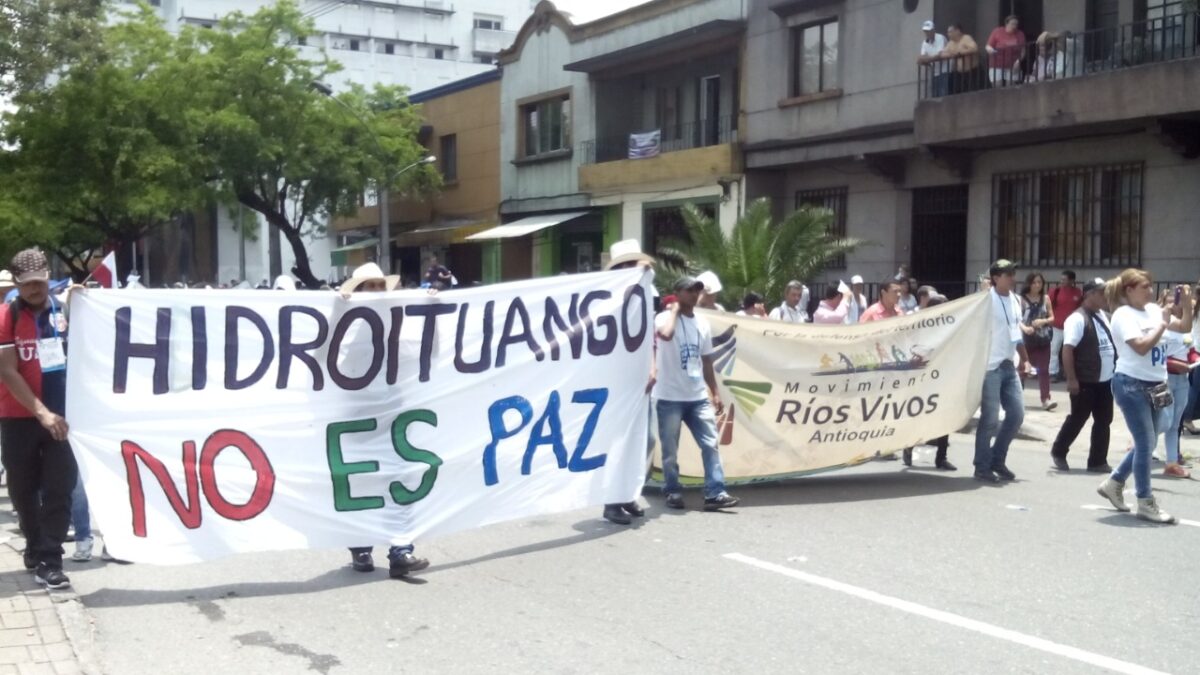
IDB-funded dam project in Colombia raises human rights concerns
Activists say the Inter-American Development Bank (IDB) is not following its own sustainability guidelines and performance standards in the case of Hidroituango, the largest hydroelectric dam in Colombia, in a struggle on how best to develop the Lower Cauca River Valley.
One day in early 2019, Isabel Zuleta remembers kneeling on the bank of the Cauca River in Colombia’s northwestern Antioquia department. This river, one of the most important in Colombia, once had a powerful and roaring stream and was the cultural and economic heart to the communities along its banks. But in recent years, construction on the Hidroituango hydroelectric dam has reduced it to a pathetic trickle.
“They’re killing the river bit by bit,” said Zuleta. “Just like they did with the massacres. Just like the assassinations. They are doing exactly the same thing to the river.”
Zuleta is a leader with Movimiento Ríos Vivos, a Colombian environmental organization which since 2008 has been locked in a battle over the Hidroituango dam, employing legal challenges and non-violent direct actions to call attention to the suffering the dam has caused.
In 2019 Ríos Vivos brought a complaint against one of the dam’s chief financiers, the Inter-American Development Bank (IDB), accusing it of violating its own operational procedures in financing the dam.
In a historic move, the IDB agreed to launch an internal investigation of the project. The oversight mechanism’s field visit has been delayed by the COVID-19 pandemic and the investigation is still underway.
The $5 billion dam is being built by Empresas Públicas Medellín (EPM), a construction firm owned by the city of Medellín, and when completed will be the biggest hydroelectric dam in Colombia. Proponents of the project say that it will generate enough power to cover 17% of the country’s needs. Its construction has already impacted as many as 26,000 people.
Since 2012, the IDB has provided over $1 billion in direct and syndicated loans, and in 2018 “announced the consolidation of a $1 billion dollar package,” which included commercial banks and institutional investors.
“Without the Inter-American Development Bank, this project never would have happened,” said Zuleta. “It generates confidence so that other banks invest. This makes it responsible, because it’s a political issue, it isn’t just about money. It’s about political responsibility for the damage they caused by investing here.”
The Independent Consultation and Investigation Mechanism (MICI), an oversight mechanism of the IDB, is charged with investigating the Ríos Vivos complaint. Ríos Vivos and the other civil society organizations who are presenting the complaint argue the bank violated policies on environment and safeguard compliance, access to information, among others. As most of the loan came from the bank’s private lending arm, they also cite violations of its performance standards for private lending.
For example, they note that the IDB guidelines “require compliance with specific standards for conducting Environmental Impact Assessments (EIA).”
Yet EPM did construction on the dam that wasn’t approved in its environmental license, leading to disaster.
During the construction of the dam, there are tunnels that divert the river from its original course to allow the river to flow before the dam is operational. EPM had made a smaller tunnel, not approved in its license, which landslides and rains caused to clog, leading to flooding, the near collapse of the dam and the evacuation of tens of thousands of people.
In 2021 the Colombian environmental authority fined Hidroituango 5.5 billion pesos (US $1.5 million) for these modifications, bringing the number of fines by the environmental authority to over 9 billion pesos ($2.4 million).
Furthermore, EPM cites geological instability as one of the reasons for the landslides, a risk the communities had tried to warn EPM about.
“Those faults have always been there in the Andes,” Zuleta said. “We talked about these faults in 2012, we have a document we published that year. We said we were very worried because this land moves.”
Sloppy planning was also signaled in a 2018 report from the National Comptroller:
“There are many weaknesses and errors found by the Comptroller in the different stages of the licensing process, such as the approval of the license by the then Ministry of Environment, Housing and Territorial Development without sufficient, detailed and updated studies and designs for the time, which allowed for the location of the megaproject in areas with high geological risk, since the territory where it is located is crossed by more than 11 recognized geological faults. [The project] will affect the life, culture and economy of more than 26,000 people.”
In December 2020, the National Comptroller filed administrative charges against 28 former officials implicated in the recurring failures of the project. If found to be responsible, the officials could be on the hook for 4.1 billion pesos.
The MICI investigation has been held up since the onset of the COVID-19 pandemic, but Ríos Vivos is still in communication with them to prepare for a future field visit.
“We believe [the visit] is fundamental, so that they don’t only hear what we have to say but also so they can see all the problems for themselves,” Zuleta said.
Ríos Vivos had a meeting with experts from the MICI earlier this year, which Zuleta felt was positive.
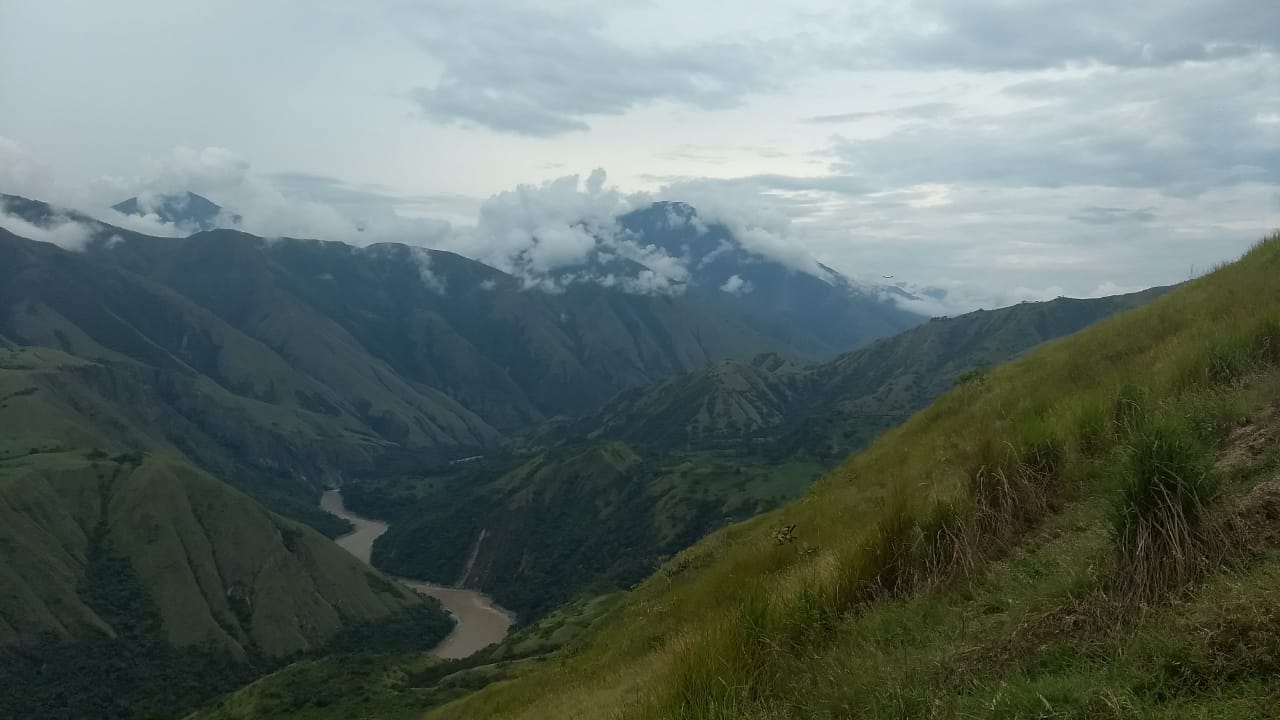
The Cauca River in the bajo Cauca region. Photo courtesy of Movimiento Ríos Vivos
How has the Lower Cauca River Valley Developed?
The dam’s slick website calls Hidroituango “the largest infrastructure project in Colombia” and makes bold claims about the benefits the dam will bring:
“Hidroituango is a country project. The energy that it will generate will permit the fulfilment of the rising electric energy demand in Colombia and therefore will contribute to a better competitiveness and productivity, and a better future for Colombians.”
It also lays out the investment that Hidroituango does in local communities, claiming it works together with local governments and communities.
Two years after the 2018 emergency that led to the evacuation of tens of thousands of people, then-General Manager of EPM Álvaro Guillermo Rendón spoke to the progress the dam has made, pivoting to the benefits they will bring.
“In these two years of contingency, our company has spared no effort or resources to reduce the risks of the populations located downstream of the project and to move forward with one of the most important infrastructure works in the country, which when fully operational will generate 2,400 megawatts of energy to meet the needs of more than eight million Colombian households, in a contribution to their quality of life and development,” he said.
Zuleta doesn’t consider the dam and its financiers to be developing anything.
“They don’t care that people became poorer,” she said. “How can this be called a ‘development bank’ when what it generates is poverty, misery, and underdevelopment. Is this a word game or what? How can this be development if I no longer have fish, if I can’t feed myself?”
Ríos Vivos has documented forced evictions of people who live in the area around the dam, and whole communities are leaving as they can no longer access the river. Lands traditionally used by “Barequeros” — small scale miners — have been privatized, and water and environmental pollution and degradation has left fishermen without fish to catch.
Decision makers on these types of “development projects” are socialized in career paths that go between government, bank, and industry.
“The connection between how decisions are made on national development and the connections between these banks is very close,” said Carla García Zendejas, an attorney at the Center for International Environmental Law (CIEL), one of the organizations supporting Ríos Vivos. “The outgoing president of the IDB and the President of Colombia worked very closely when they were both at the IDB. These national projects are pushed forward in a very obvious way because of relationships that have been created before.”
Since 2016, Luis Gabriel Azevedo has been the chief of the IDB’s environmental, social, and corporate governance division. Previously, he worked at Brazilian construction company Odebrecht from 2008-2016 as sustainability director during the construction of the Belo Monte Dam, a project which led to the displacement of 20,000 people. This was the same time Odebrecht got caught up in an international bribery scheme.
When García Zendejas met with Eliot Pedrosa when he was the U.S. executive director at the IDB and the subject of Hidroituango came up, he said he would have to recuse himself from discussion, showing the reach of Hidroituango’s influence. While Pedrosa did not say why he had to recuse himself, Pedrosa worked for Greenberg Traurig, an international law firm based in Miami, Florida which had hired lawyers from Winston & Strawn, a law firm which has EPM as a client on the Hidroituango project.
Hidroituango did not return repeated attempts to request an interview. In a request for an interview, the IDB pointed to their sustainability policies and noted that the case is currently under investigation by the MICI.
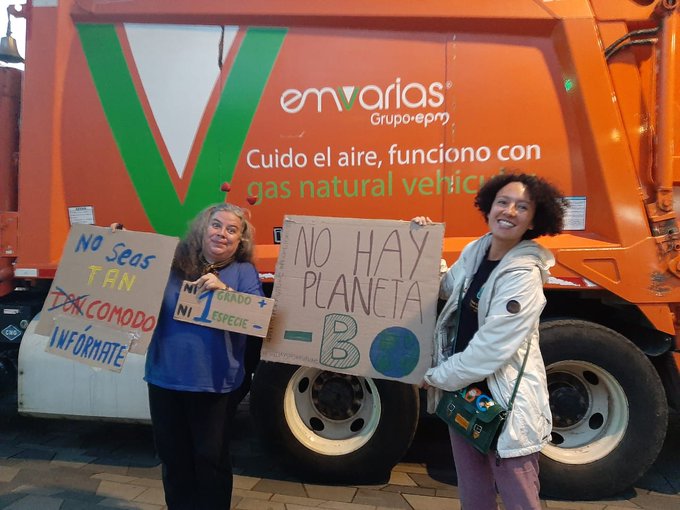
Photo courtesy of Movimiento Ríos Vivos
Political Violence in “Bajo Cauca”
Hidroituango is being built in the midst of conflict.
“Another failure of the bank is that they don’t have policies that adjust to contexts of generalized violence,” said Carlos Lozano, a member of the Association for Environmental Defense (AIDA). “There, daily life is very different from areas that have state presence. And if a bank is going to invest money there, the minimum that they should do is, in terms of what to evaluate, is what the dynamics of the area are and what it implies to invest money there and how it will impact communities.”
For decades the FARC, Colombian army, and paramilitaries have contested this region, each vying for territorial control. The municipality of Ituango suffered a series of high-profile massacres in the 1990s, which the Inter-American Court of Human Rights ruled on in 2006, and in 2018 the Colombian Supreme Court ruled a crime against humanity.
“You don’t need to be an expert in security to know there were massacres here and the cruelty that we have suffered,” Zuleta said, questioning the logic of investing in a major infrastructure project in a conflict zone. “Hidroituango is an armed actor that disputes territory just like all of the other armed actors.”
Given the ongoing conflict, the dam hosts military bases on EPM property, and the company pays the armed forces directly for security. In a 2018 hearing, Colombian senator Iván Cepeda laid out a series of allegations of human rights violations involving units financed by the security agreements between Hidroituango and the defense ministry including threats, torture, and evictions.
Members of Ríos Vivos have also been victims of political violence. Between 2013 and 2018 they were subject to 151 attacks including homicides, death threats, and torture. Zuleta said that 2018, the year they first filed the complaint, was one of the worst and they remain under threat today.
“We sent many emails to IDB board members when a person was killed, over a year ago, or when another person was criminalized, we keep sending information, we rarely even hear a ‘thank you for the emails’,” García Zendejas said, adding that staff from the U.S. executive director’s office do respond.
CIEL has also warned the United States State Department and Treasury, but there has been little action.
In the Lower Cauca River Valley, Zuleta and Ríos Vivos will continue to denounce human rights violations and innovate ways to defend the environment. While the most they can hope to get out of the MICI is a 100-page report with unbinding resolutions, they are working with other communities affected by the BID to demand justice.
“What we are hoping for is a rigorous investigation,” Zuleta said. “One which shows that the bank didn’t fulfill its internal policies. And after showing this, that the bank withdraws its investment from Hidroituango.”
Thomas Power is a candidate for a master’s degree in Estudios Políticos (Political Studies) in the Universidad Nacional de Colombia (Universidad Nacional of Colombia) and was an International Human Rights Accompanier with Fellowship of Reconciliation from 2016-2018, where he continues to collaborate. He tweets at @ahbueno55